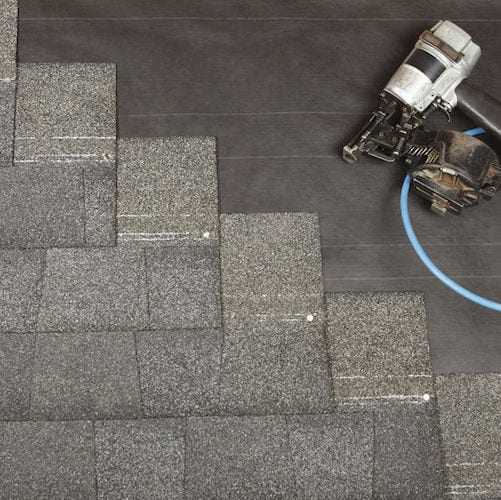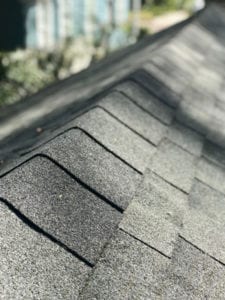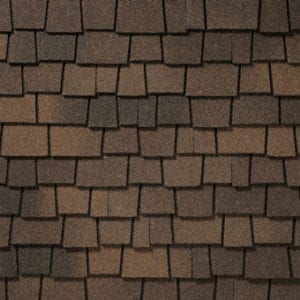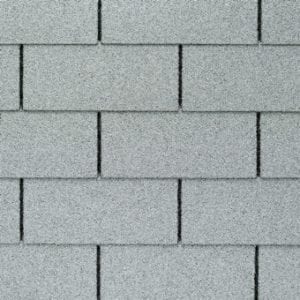
Asphalt shingles were invented in America in 1901 as a low cost and fire resistant alternative to the available roofing materials of the day. They were originally cotton rag soaked in asphalt with a variety of granules such as slate, mica, or even oyster shells added to the the surface for increased durability.
You might not give much thought to asphalt shingles since most of us don’t see our roofs up close unless there is a problem or you’re just particularly fond of heights. But you should definitely give your shingles a considerable amount of thought when it comes time to replace your roof because they are the main thing protecting your house from the weather. Even more important than keeping your house painted, the proper asphalt shingles (installed well) can make your roof last a decade longer than a poor shingle.
In this post, I’ll give you my take from experience as a general contractor of what shingles work and what are not worth your time. There are a lot of things to consider when choosing the right asphalt shingle and I’ll walk you through the things you should be paying attention to since the cost of the shingle is such a small portion of the overall cost of a new roof.
A History of Asphalt Shingles

The first shingles were originally just single shingles unlike the wide multi-shingle sheets on the market today. Over the years, the backing material, granules, and construction of asphalt shingles has changed considerably, but the basic premise has remained the same. Their resistance to wind and hail damage has been greatly increased over the years as have the styles available to create a high quality roofing material.
Like most building materials, the composition of asphalt shingles was largely natural materials at first before moving to more manmade versions later. In the 1920s, due to increasing costs, the original cotton backing soon became too expensive and other materials like wool, jute (see linoleum), and wood pulp were experimented with. In testing done around the time, most of these bases showed no significant performance differences so for the next couple decades there were a variety of backings used depending on the region and manufacturer.
The 1920s saw huge growth for asphalt shingles due to a campaign by the insurance companies to address the growing fire risks in America’s cities. Wood shingles, while popular and affordable created significant fire risks, whereas asphalt shingles provided fire resistance and affordability. With the advent of the great depression and asphalt shingles availability as an affordable roofing material, they only saw further growth through the post war building boom and following decades.
In the 1960s, fiberglass mats were introduced to further improve fire ratings of roofs and replace the asbestos containing shingles that found their way onto the market. While fiberglass shingles were too light to withstand high winds, originally they were eventually improved to the point where they surpassed asphalt shingles with natural backings popularity in 1982.
In the 1990s, manufacturers worked very hard to improve the wind resistance and impact resistance of asphalt shingles, especially following devastating hurricanes like Andrew in 1992. Today asphalt shingles have been improved so thoroughly that many receive the highest wind and impact ratings available for roofing materials.
What to Look For
Since the cost of a new roof is mainly labor, picking a more expensive shingle is not as financially painful as you might think. Doubling the cost of your shingles adds only a small increase to the total cost of a roof. So what should you be looking for in a quality shingle? Just like anything you do get what you pay for so even if a cheap shingle looks great, there should always be some skepticism about why it’s so cheap. Let me outline the important aspects of asphalt shingles here.
Wind Rating
You want a shingle to stand up to storms especially if you live in a high wind region like Florida or the plains which are subject to hurricanes or tornados. Yes, you can save a little here if you don’t live in a high wind zone, but is it really worth it since the chances or a strong storm coming through your area in the next 20 or 30 years is pretty good no matter where you live. Below is a list of wind ratings for roofing materials.
Asphalt Shingle Wind-Resistance Classifications
| A | 60 MPH |
| D | 90 MPH |
| F | 110 MPH |
| G | 120 MPH |
| H | 150 MPH |
Impact Resistance
A beneficial feature you may want to consider is what impact rating your shingles need. There are four levels of impact resistance, which essentially measure how well the fiberglass mat will hold up to hail and other debris. The higher the rating the stronger the shingles resistance to hail hitting your roof. That’s never a bad thing. Unlike the the wind resistance, I think that paying for the highest impact rating is not a forgone conclusion. You need to think long and hard about the kind of weather your area gets before deciding which impact level is right for your house.
Asphalt Shingle Impact-Resistance Classifications
| 1 | 1 1/4″ steel ball dropped at 12 feet |
| 2 | 1 1/2″ steel ball dropped at 15 feet |
| 3 | 1 3/4″ steel ball dropped at 17 feet |
| 4 | 2″ steel ball dropped at 20 feet |
I like having a little fun with testing products and the video below is a great example of what Class 3 and 4 shingles can stand up to. Grab a soda and check it out!
Style

The traditional 3-tab shingle has been around for years, but in the last couple decades, the rise in popularity of architectural shingles which do a good job of replicating the texture and dimensions of wood shingles has in my mind been a big improvement. Architectural shingles tend to last longer and hold up better since they are thicker and generally built with better construction. You can find scalloped shingles, shingles made to look like wood shakes, and all kinds of other custom shapes to fit the style of your house. This is especially helpful to us old home owners who need something that matches the architectural style of a historic home.
There is no right or wrong decision here, but the style is definitely something you should be thinking about since you’ll be living with it for a long time.
Color
Color is a bigger deal than you might think. Yes, it defines the look of your house and is more difficult to change than a bad paint job, but it also plays a large role in how energy efficient your house is. When I hear people rail about how important energy efficiency is and then watch them put a black shingle roof on their house I realize that all their talk of “green living” is likely just talk.

The lighter shade of shingle you choose greatly affects the heat generated by your roof. In northern states, a dark roof might well be desirable to capture as much heat from the elusive winter sun, but if you live in the south, then having black roof can increase your cooling bill significantly.
A study performed by Berkeley Labs which compared the different energy performance between black, white, and green roofs (a green roof is a roof covered in vegetation) found that “Both white and green roofs do a good job at cooling the building and cooling the air in the city, but white roofs are three times more effective at countering climate change than green roofs.”
I’m not saying you should go out and buy stark white shingles, but realizing the huge difference that shingle color can play should definitely weigh in on you decision of what shingle to buy. Think of it this way, on a sunny day, a black roof can be as much as 100 degrees warmer than the ambient air temp, while a white roof will only be about 20 degrees warmer. Think about not only your utility bills, but also the fact that a roof assembly that stays cooler has a longer life than shingles that are consistently overheated.
Warranty
There are a lot of warranties out there and while I’m not as focused on this aspect, it is often important to look into since your roof is a significant investment. Does the warranty cover materials only or does it cover materials and labor. Is it pro-rated or is it full coverage? How long does it last? How established is the company? If you have a 100-year warranty from a 2-year old company, that’s not quite as valuable as from an 80-year old company since your warranty is only as good as the company who honors it.
Picking the Best Asphalt Shingles
You should be armed with enough information to pick the right shingles at the right price for your house now. Don’t get too hung up and on the different manufacturers special options. The main issues are what we have discussed, and following these guidelines will help you compare apples to apples so you don’t accidentally end up with a lemon. Just like any home improvement purchase, take your time and put your hands on some shingles before making the final decision.
Do they feel significant or do they feel cheap and weak? Your gut is a good guide once you can get the product in your hands and see it in real life rather than on a computer screen. Use the facts above and trust your gut and you’ll be just fine. Happy roofing!

Founder & Editor-in-Chief
I love old houses, working with my hands, and teaching others the excitment of doing it yourself! Everything is teachable if you only give it the chance.


I would have put ice and water shield in the valley with a open “w”metal valley always replace old metal I used tar on all my job as long tha it under metal,shingles and it never see the sun it will last for a long time as long as the sun doesn’t dry for the drip edge it should have a kicker on the bottom so it can drip in the gutter
Hey Scott,
Quick question for you, my house was built in 1874 and its located in Massachusetts. I am in the market for a new roof and have got multiple quotes so far. Most of the roofing contractors are saying they will need ridge vent.
The house has lasted 140+ years without one so I am not sure whats best, Any thoughts?
Thanks Scott!
A ridge vent is never a bad thing in my mind.
I got the architectural 50-year shingle when we had our house reroofed 8 years ago, and it cost about $1000 more than the basic 30-year shingles. We went for the higher quality shingle, hoping it would last longer than the standard.
We got multiple quotes from roofers and they were all about the same, but chose a company that came highly recommended by the children of the previous owner and by the landlord of the house we were renting, and they also did some general contracting work and so were able to do some repairs and insulation during installation. I did not research too deeply about roof installation, but my energy audit guy/former contractor did talk to them and made sure they used fire-rated foam and caulk around the chimney and so forth.
I assumed they were professionals and knew what they were doing. Since then, I have had problems and it is not the shingles themselves, but how they were installed, and probably how our old house was built and is insulated. I bet I am not alone with some of these problems. My background is historic preservation, and after getting burned by contractors, I have since worked very hard to educate myself on these matters, but no good solution appears available to me, short of gutting the second floor, and I can’t afford that.
Our house was built in the 1890s and was remodeled into a bungalow in the 1920s and had a gut rehab in the early 1960s. We have a simple rather steep front-facing gable roof with very deep eaves and one South-facing dormer and a gable-roofed front porch. The dormer has developed a lot of problems, aggravated by the extreme weather we have had and lots of ice dams this year. The roof is not well insulated since most of it abuts living area.
These are the problems I’ve had, and I hear that they are fairly common:
a) The valleys were not interwoven, but were cut on the diagonal to overlapping shingles from the main roof. I think they are leaking–I have since had silicon caulk put up there to try to stem leaks.
b) From the pattern of leaks around the dormer, it looks like no snow and ice barrier was put around the dripline of the dormer eaves, perhaps only one row of snow and ice barrier on the eves, which only extends a foot or so over the top of the walls.
c. I asked the roofers about the step flashing at the time they installed the roof, and they assured me the old flashing was OK (we had organic shingles and the roof was not that old). Now it appears that it does not go up all the way along the dormer and the top portion under the soffit where it meets the roof is open. I’ve had chicken wire (to keep the critters out) and sprayfoam and tar and caulk installed to try to seal these areas off.
d. The shingles were cut rather far from the siding, leaving about an inch gap. I have had these filled with tar.
e. We asked for diverters at the end of the step flashing on the porch gable to keep water from splashing onto the adjoining wall. They installed a horizontal diverter about 3 feet from the end of the gable, not a piece of flashing bent to divert water away from the wall.
f. They installed continuous flashing rather than step flashing around the chimney and probably caulked,not mortared, it in. I don’t know if they installed a new boot around the vent stack or not, but we have had condensation problems with that inside an unheated storage room under the eaves. I hated how it looked so they painted it to match the brick.
g. They installed the drip edge tight to the existing fascia trim, rather than leaving a gap to allow water to drip outside of the aluminum covering. Who knows what shape the original barge boards are in underneath.
h. I had ridge vents installed on all the roofs and did not close the existing gable vents. The soffits are not vented, but I installed proper vents anyway for the parts we insulated (part fiberglass plus foamboard, part exposed Thermax, blown cellulose in the porch gable) to provide an air gap in case of water infiltration and future modifications. The soffits are in good condition and I have been afraid of opening them up to install soffit vents. Every contractor I have asked about it says not to do it.
i. We did install gutters with leaf guards, and they have been great, but provided a shelf tor the ice dams this year.
Now what? I can’t afford to replace the roof or partially gut demo the upper floor. The plaster has completely failed in my master bedroom closet next to the dormer and was leaking water. I’m keeping an eye on it to see if we sealed the leaks before we tear that out and replace. The original roofer has since retired and my current roofer/handyman says he can’t really tear off just the dormer area and redo that part of the roof, or install an open valley or metal flashing around the edges. He is not a fan of heating cables and the roof is almost too high for a roof rake (I can barely get the edge with two 8′ extension poles.) He says the caulk and tar will only last 3-5 years, and I was hoping that this roof would last 25-30 years.
Like many around here in Northern WI this year, I hired to have the roof cleared for the spring thaw. Normally I only get really bad icicles over where the air vent for the furnace and dryer is, but this year they covered the whole house. I knocked off what I could before I hired help. .
Complicating things, we have knob and tube running through some of our interior walls and connecting along the ridgeline and the electricians don’t think I should touch it, so I am afraid to insulated more in the attic proper. I have about 3′ of sloped ceiling covered in plaster and lathe and a layer of drywall to tear out in all the bedrooms to fully insulate the sloping roof, and I can only get it to maybe a R17. I’ve considered foam, but there are problems with uneven curing and I try to use it as little as possible. I considered blowing cellulose, but I worried about moisture and did not want it to pour into the wall cavities (we have balloon framing), and blown mineral wool is not available here.
We want to sell the house next year, but I don’t want to pass on any problems and I am at a real quandary what to do. I have a lot of other repairs to do, and the market will not give hardly any return on what I put into the house. But I can’t bear not to do right by it.
Should never of reroofed always tear it down to the decking check the wood and install the right ice and water shield.. a lot of issues goin on there but sounds like insulation issues and not a proper installation.. when you cover up an old roof that’s exactly what your doing.. we never warranty a reroof but do our best to address any existing issues..
good luck
Kathy –
Without being onsite to inspect all of the issues you are describing, it would be almost impossible to comprehensively diagnose the issues you are describing. I want to shed light on a possibility that you may not be aware of: If you have a tall; steep roof, you may not be getting the most accurate assessment of your situation or the possible solutions (busy contractors don’t like to do scary, difficult, dangerous repairs that don’t have a clear solution prior to digging in), make sense? Not saying that is happening but it’s a possibility
*Below are exactly what you need to know and when hiring a contractor, you’ll need to tell them exactly what you want them to do rather than asking their opinion regarding solutions.
a) Your valley doesn’t need to be woven or open, Cali Cut, which is what you described, is plenty sufficient. The installers either didn’t install Ice and Water Shield, Nailed Shingles too close to the valley, or unintentionally made a Tear in the Ice and Water Shield during install
b)You need a 2 courses of Ice and Water Shield
c)New Flashing all the way around. Sounds like they didn’t do that part correctly
Install Power vents on each attic cavity. These should be connected together on a switch, not a solar cell with thermostat. Reason being, you need to be able to turn the power vent on in the winter and let it run continuously if necessary. The power vents will remove the hot air from the attic that is causing the ice damming. Also, Spray foam insulate everything possible.
***Tell the contractors what you want and make them provide proof they did exactly what you hired them to do.
Your Friend – Nick Button Boulevard Building Company